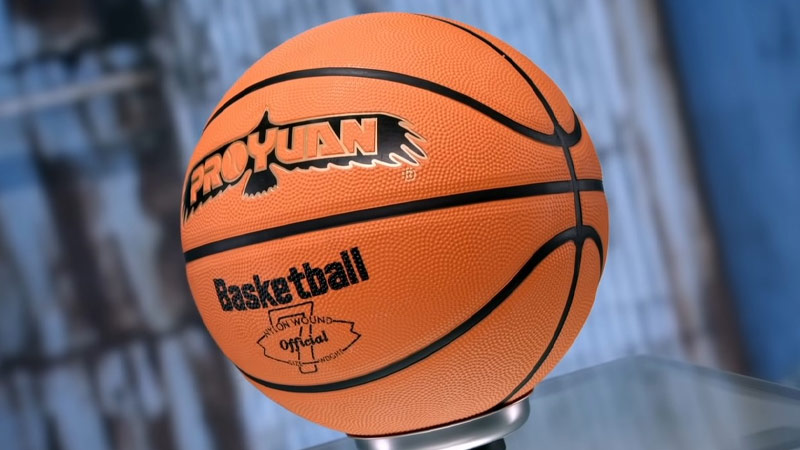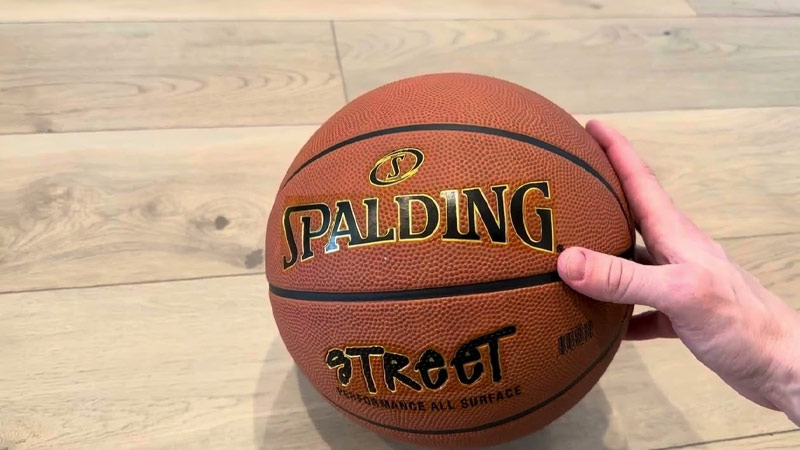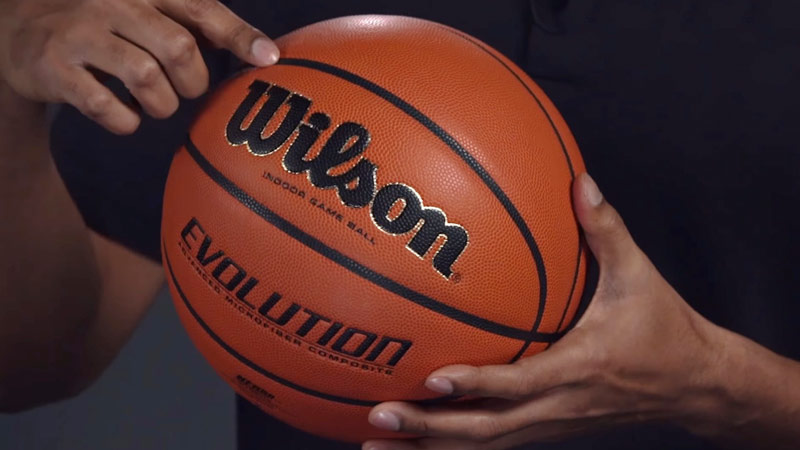Basketball is a beloved sport played by millions around the world. While players focus on perfecting their shooting skills and honing their dribbling techniques, have you ever wondered what goes into the making of a basketball?
This article aims to explore the materials used in crafting a basketball and shed light on the manufacturing process.
We will also highlight the key differences between popular basketball brands like Spalding and Wilson. Let’s get started.
What Is a Basketball Made Of?
Basketballs are typically made of a combination of materials that contribute to their durability, grip, and performance. The outer covering, also known as the “skin,” is commonly made from synthetic leather or composite leather.
These materials provide a soft and grippy surface that allows players to maintain better control of the ball.
The inner bladder, responsible for maintaining the ball’s shape and air pressure, is typically made of rubber or latex. These materials offer elasticity and ensure that the ball bounces consistently.
In terms of specific brands, Spalding, a renowned basketball manufacturer, often uses composite leather for their basketballs’ outer covering.
Composite leather is a synthetic material that closely resembles genuine leather but offers enhanced durability and a more affordable price point.
Wilson, another popular basketball brand, also utilizes composite leather or a combination of leather and synthetic materials for their basketballs.
The exact composition and construction methods can vary between brands and models, but the goal is to create a basketball that delivers optimal performance and durability for players of all skill levels.
What Types of Materials Are Used to Make Basketball?

Basketballs are constructed using a combination of materials, each serving a specific purpose. The outer covering, commonly known as the basketball’s “skin,” and the inner bladder play vital roles in the ball’s performance.
Let’s delve deeper into these materials and explore the specific choices made by two renowned basketball brands: Spalding and Wilson.
Outer Covering – Synthetic Leather and Composite Leather
The outer covering of a basketball often referred to as the skin is responsible for providing durability, grip, and a consistent bounce. Two commonly used materials for basketball covers are synthetic leather and composite leather.
Synthetic Leather
Synthetic leather is a man-made material designed to mimic the texture and appearance of genuine leather.
It is typically constructed using a polyurethane or PVC (polyvinyl chloride) base combined with various additives and coatings. Synthetic leather offers several advantages for basketball construction:
Durability: Synthetic leather basketballs are highly durable and resistant to wear and tear, making them ideal for outdoor play and rougher surfaces.
Consistent Grip: The synthetic material is engineered to provide a reliable grip, allowing players to maintain control of the ball during dribbling, shooting, and passing.
Cost-Effective: Synthetic leather basketballs are often more affordable compared to those made with genuine leather, making them accessible to a wider range of players.
Composite Leather
Composite leather is a blend of synthetic materials, such as polyurethane or microfiber, and natural leather particles.
This combination offers the benefits of both synthetic and genuine leather, resulting in a high-performance basketball. Here’s why composite leather is favored by many basketball manufacturers:
Soft and Grippy Surface: Composite leather basketballs provide a soft and grippy surface similar to genuine leather. This enhances player control and improves ball handling, allowing for precise dribbling and shooting.
Enhanced Durability: The synthetic materials in the composite blend enhance the durability of the basketball, making it suitable for both indoor and outdoor play.
Balanced Performance: Composite leather basketballs strike a balance between performance and affordability, offering a reliable option for players at various skill levels.
Spalding and Wilson, two renowned basketball brands, utilize a combination of these materials in their basketball construction.
Their specific choices of synthetic leather or composite leather are based on extensive research and development to ensure optimal performance, durability, and player satisfaction.
Materials of Spalding Basketballs

Spalding, a renowned basketball brand, is recognized for its commitment to using high-quality materials in their basketball manufacturing process. Let’s explore the specific materials that make up Spalding basketballs:
Composite Leather Cover
Spalding basketballs often feature a composite leather cover that combines synthetic materials with leather particles. This construction offers the best of both worlds – the durability and consistency of synthetic materials, along with the natural feel and grip of leather.
The composite leather cover provides players with a surface that is both durable and responsive, allowing for enhanced control and a reliable grip. It withstands rigorous play and provides consistent performance over time.
Rubber Bladder
Inside Spalding basketballs, you’ll typically find a rubber bladder. Rubber bladders are known for their excellent air retention properties, ensuring that the ball maintains its optimal shape and pressure for extended periods.
The rubber bladder also contributes to the basketball’s bounce, delivering a consistent performance on the court.
Materials of Wilson Basketball
Wilson, another prominent basketball brand, also prioritizes top-notch materials in their basketball production. Here are the materials commonly used in Wilson basketballs:
Composite Leather or Leather-Synthetic Combination Cover
Wilson basketballs are commonly made with a composite leather cover or a combination of leather and synthetic materials. This blend provides a balance of durability, grip, and performance.
The composite leather cover offers enhanced durability and consistency compared to traditional leather, while the incorporation of synthetic materials ensures optimal grip and a responsive feel.
This combination results in a basketball that can withstand tough gameplay while providing players with the necessary control and touch.
Rubber or Latex Bladder

Wilson basketballs typically incorporate a rubber or latex bladder. These materials are chosen for their ability to maintain optimal air pressure and deliver consistent bounce.
The bladder’s composition ensures that the ball retains its shape and performance characteristics throughout extended play sessions.
The rubber or latex bladder contributes to the overall playability of the Wilson basketballs, offering a reliable and responsive experience on the court.
By carefully selecting materials such as composite leather covers and rubber or latex bladders, both Spalding and Wilson create basketballs that meet the demands of players at various skill levels.
These materials provide the necessary durability, grip, and performance characteristics, ensuring an enjoyable and reliable playing experience.
How Does the Manufacturer Make Basketballs?
The manufacturing process of basketballs involves several key steps, ensuring that the final product meets the required standards of quality and performance. Let’s delve deeper into each stage of the manufacturing process:
Cutting and Stitching the Outer Cover
The first step involves cutting the outer cover material, which is typically synthetic leather or composite leather, into individual panels. These panels are shaped to precise dimensions and then stitched together.
The stitching process requires precision and specialized techniques to ensure a secure and durable bond between the panels. The number of panels used can vary, but the traditional basketball design consists of six or eight panels.
Forming the Spherical Shape
Once the panels are stitched together, they are combined to form the spherical shape of the basketball. The stitching lines seamlessly connect the panels, ensuring a smooth surface without any prominent seams that could interfere with grip or bounce.
Inserting the Bladder
After the outer cover is complete, the next step involves inserting the bladder. The bladder, typically made of rubber or latex, is an inflatable component that maintains the ball’s shape and air pressure.
It is carefully inserted through a small opening in the cover and positioned in the center of the basketball.
Inflation and Air Pressure Adjustment
Once the bladder is in place, the basketball is inflated to the desired air pressure. Manufacturers follow specific guidelines for inflation to ensure consistent bounce and playability.
The air pressure is adjusted to achieve the right balance between firmness and responsiveness, providing optimal performance on the court.
Quality Control Checks
To ensure that each basketball meets the required standards, thorough quality control checks are conducted.
These checks involve examining the stitching, inspecting the cover for any defects or imperfections, and verifying the proper inflation and air pressure.
Only basketballs that pass these stringent quality control measures are deemed suitable for distribution.
FAQs
Why are basketballs made with synthetic leather or composite leather?
Synthetic leather or composite leather materials offer durability, consistent grip, and a better feel compared to traditional leather. They also provide a more affordable and sustainable option.
What is the purpose of the rubber or latex bladder inside a basketball?
The bladder maintains the ball’s shape, structure, and air pressure. It ensures the basketball retains its bounce and remains playable during games.
Are Spalding basketballs better than Wilson basketballs?
The preference between Spalding and Wilson basketballs often comes down to personal preference. Both brands offer high-quality basketballs with varying features, and players often choose based on their individual needs and playing style.
Can the cover of a basketball be customized with team logos or designs?
Yes, some basketball manufacturers offer customization options, allowing teams or individuals to have their logos or designs printed on the basketball’s cover. This adds a personalized touch to the basketballs.
How long does a basketball typically last?
The lifespan of a basketball depends on various factors, including usage, playing surface, and maintenance. With proper care, a basketball can last for several months to a few years of regular play.
Bottom Line
The materials used in the construction of basketballs provide valuable insight into the quality, performance, and durability of these sporting essentials.
Whether it’s the synthetic leather cover, rubber or latex bladder, or the intricate manufacturing process, each component contributes to the overall feel and playability of a basketball.
Whether you choose a Spalding or Wilson basketball, selecting a well-crafted ball made with top-quality materials ensures an enjoyable and reliable basketball experience.
So, the next time you step onto the court, take a moment and read this article. Thank you.







